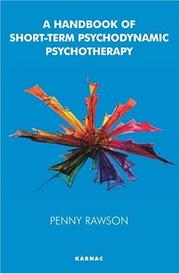| Listing 1 - 10 of 148 | << page >> |
Sort by
|
Book
ISBN: 1868146049 Year: 2013 Publisher: Johannesburg : Wits University Press,
Abstract | Keywords | Export | Availability | Bookmark
 Loading...
Loading...Choose an application
- Reference Manager
- EndNote
- RefWorks (Direct export to RefWorks)
Psychoanalysis as a long term modality is inaccessible to the average South African. In this book the authors describe how psychoanalytically orientated or psychodynamic psychotherapy can be practiced as a short-term endeavour and applied to contemporary issues facing the country. Psychodynamic work is currently undertaken by clinical psychologists, therapists, clinicians, trainers, teachers, clinical supervisors, consultants and researchers working in university settings, state hospitals, community projects, private practice and research. The debates, clinical issues, therapeutic practice and nature of research covered in the book are widely representative of the work being done in the country. The need for shorter term therapy models and evidence-based interventions is as acute in global practice as it is locally. The lessons learned in South Africa have broader implications for international practitioners, and the authors stress the potential inherent in psychoanalytic theory and technique to tackle the complex problems faced in all places and settings characterised by increasing globalisation and dislocation. The book is structured in three main sections. Psychodynamic Psychotherapy in South Africa is aimed at local and international practitioners and students, while non-specialist readers will find the text informative and accessible.
Psychodynamic psychotherapy. --- Psychodynamic psychotherapy
Book
ISBN: 2804707229 Year: 2019 Publisher: Bruxelles, Belgique : Mardaga Supérieur,
Abstract | Keywords | Export | Availability | Bookmark
 Loading...
Loading...Choose an application
- Reference Manager
- EndNote
- RefWorks (Direct export to RefWorks)
Book
Year: 2016 Publisher: Paris cedex 14 (Humensis 170 bis, boulevard du Montparnasse 75680) : Presses Universitaires de France,
Abstract | Keywords | Export | Availability | Bookmark
 Loading...
Loading...Choose an application
- Reference Manager
- EndNote
- RefWorks (Direct export to RefWorks)
La psychodynamique du travail est une discipline dévolue à l'analyse clinique et théorique des relations entre travail et santé mentale qui s'efforce d'identifier les conditions en fonction desquelles le rapport psychique au travail évolue vers la pathologie ou profite au contraire à la construction de la santé mentale. Elle prend naissance en France en 1980 avec la publication de Travail : usure mentale. Ce livre rassemble des articles qui ont joué un rôle important dans l'édification de cette discipline et qui sont, pour la plupart, devenus introuvables. Nombre de ces textes ont la forme de réponses à des objections faites à la clinique du travail par des chercheurs œuvrant dans d'autres disciplines (ergonomie, médecine du travail, sociologie, anthropologie, psychosociologie, philosophie, psychanalyse, psychosomatique). Il s'agit donc d'une sélection qui constitue une base de référence pour tous ceux qui, en tant que praticiens ou chercheurs, sont impliqués dans la clinique et dans l'action en faveur de l'amélioration des rapports entre les êtres humains et le travail.
Book
ISBN: 2807358489 2807331955 Year: 2022 Publisher: Paris : De Boeck Superieur,
Abstract | Keywords | Export | Availability | Bookmark
 Loading...
Loading...Choose an application
- Reference Manager
- EndNote
- RefWorks (Direct export to RefWorks)
" Deborah L. Cabaniss, pionnière dans la transmission du savoir pratique en psychothérapie, propose d'aider à aider, épauler le thérapeute dans son travail de contribution douce mais efficace au mieux-être de son patient. Dans cette optique, Psychothérapie psychodynamique, manuel clinique pas à pas, est un livre pour la conduite et l'application de la psychothérapie et décrit les techniques utilisées pour : l'évaluation (" Écouter ") ; le début du traitement (" Refléter ") ; la conduite d'une psychothérapie psychodynamique par des techniques d'exploration et de soutien (" Intervenir "). Comme tous les livres de psychothérapie, il est conçu pour concrétiser clairement les techniques afin que cette thérapie puisse être enseignée, transmise et étudiée de la manière la plus efficace. L'ouvrage est destiné tant aux élèves qu'aux professeurs qui enseignent aux étudiants en psychologie, psychothérapie psychanalytique, psychiatrie, soins infirmiers et conseils en orientation. "-- Quatrième de couverture.
Book
ISBN: 2100750399 Year: 2016 Publisher: Paris (5 Rue Laromiguière 75005) : Dunod,
Abstract | Keywords | Export | Availability | Bookmark
 Loading...
Loading...Choose an application
- Reference Manager
- EndNote
- RefWorks (Direct export to RefWorks)
Après avoir présenté les conséquences psychologiques d'un choc traumatique et défini le cadre thérapeutique, cet atelier expose les principaux traitements actuels du traumatisme psychique :les thérapies validées par la recherche et les consensus professionnels (TCC, EMDR, thérapies psychodynamiques, hypnose ericksonienne) ;les techniques recommandées comme le débriefing, les groupes de parole, la prise en charge familiale, la relaxation et autres techniques de gestion des émotions ;le traitement de deux graves complications consécutives aux comorbidités les plus fréquentes : dépression-suicide et addictions.Cet ouvrage à visée pratique comporte de nombreux documents de travail (modèles de fiches évaluatives et de dossiers patients, tableaux synthétiques…) et de très nombreux cas cliniques.

ISBN: 1585621854 Year: 2005 Publisher: Washington APA (American Psychological Association)
Abstract | Keywords | Export | Availability | Bookmark
 Loading...
Loading...Choose an application
- Reference Manager
- EndNote
- RefWorks (Direct export to RefWorks)
Periodical
ISSN: 21967989 Year: 1968 Publisher: Germany : Vandenhoeck u. Ruprecht,
Abstract | Keywords | Export | Availability | Bookmark
 Loading...
Loading...Choose an application
- Reference Manager
- EndNote
- RefWorks (Direct export to RefWorks)
Die Zeitschrift Gruppenpsychotherapie und Gruppendynamik, 1968 gegründet, ist seitdem publizistische Heimat der deutschsprachigen Gruppenpsychotherapie. Seit 2010 führt sie den Untertitel "Zeitschrift für Theorie und Praxis der Gruppenanalyse". "Gruppenpsychotherapie und Gruppendynamik" ist die Zeitschrift für alle Entwicklungen im Bereich des Arbeitens mit Gruppen - im therapeutischen, sozialen und pädagogischen Bereich, in Beratung, Organisationsentwicklung und Aus- und Weiterbildung. Die Zeitschrift setzt Schwerpunkte im Bereich gruppenanalytischer, gruppendynamischer und psychoanalytischer Konzepte; sie ist gleichermaßen offen für theoretische und empirische Arbeiten mit humanistischem, systemischem, sozialpsychologischem und behavioristischem Hintergrund. Ziel der Zeitschrift ist es, der Ort für konzeptuelle und empirische Arbeiten über Gruppen im deutschsprachigen Raum zu sein, der den wissenschaftlichen Fortschritt in Praxis und Theorie auf der Höhe der Zeit wiedergibt. Gegründet von Raymond Battegay, Helmut Enke, Annelise Heigl-Evers, Hans Strotzka, Ambros Uchtenhagen.

ISBN: 1780495854 0429910320 0429896093 0429471327 1283249359 9786613249357 1849404909 9781849404907 9781780495859 9781855753044 Year: 2005 Publisher: [London] : Karnac,
Abstract | Keywords | Export | Availability | Bookmark
 Loading...
Loading...Choose an application
- Reference Manager
- EndNote
- RefWorks (Direct export to RefWorks)
Short-term psychotherapy has become more and more popular in recent years and there is an increasing need for therapists to be able to offer help without entering into many years of therapy. This practical volume is an introductory text and a quick reference guide to short-term therapy, by an experienced therapist and teacher of psychodynamic short-term therapy. It is based on lectures given on the topic to experienced therapists wanting to familiarise themselves with short-term therapy. In a clear and concise manner, the author explores the basics of this approach and moves on to discuss such topics as the importance of the first session; the timescale of the therapy, the different techniques; and ending of analysis. Full of useful tables and bullet points, this volume is an indispensable guide to short-term psychodynamic therapy for experienced therapists as well as laypeople who are interested in learning more about this method of therapy.
Book
ISBN: 1462538665 Year: 2018 Publisher: New York ; London : The Guilford Press,
Abstract | Keywords | Export | Availability | Bookmark
 Loading...
Loading...Choose an application
- Reference Manager
- EndNote
- RefWorks (Direct export to RefWorks)
Book
Year: 1918 Publisher: New York, NY : Columbia University Press,
Abstract | Keywords | Export | Availability | Bookmark
 Loading...
Loading...Choose an application
- Reference Manager
- EndNote
- RefWorks (Direct export to RefWorks)
This book presents enlarged and modified versions of the the Jesup Lectures for 1916-1917, given at the American Museum of Natural History with the cooperation of Columbia University.
| Listing 1 - 10 of 148 | << page >> |
Sort by
|

 Search
Search Feedback
Feedback About UniCat
About UniCat  Help
Help News
News